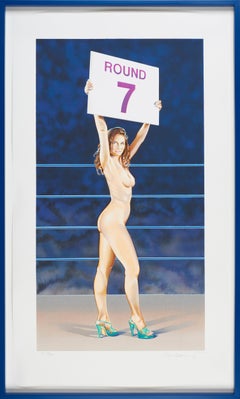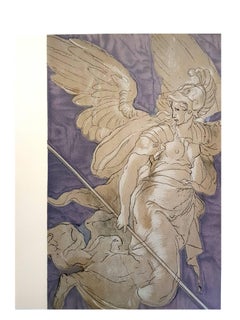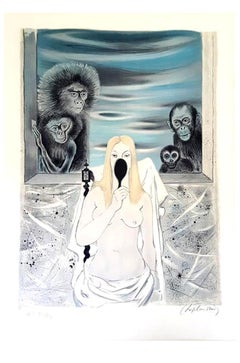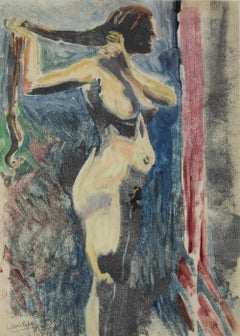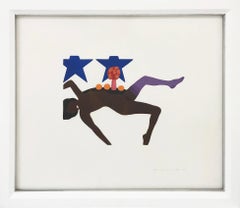Nude Prints
to
272
1,059
471
596
171
118
Overall Width
to
Overall Height
to
645
615
252
190
82
65
50
20
20
11
9
6
3
1
93
62
56
56
43
21
57
1,888
470
24
82
120
127
53
142
214
493
245
102
16
1,569
792
45
1,822
1,136
860
726
451
422
400
381
263
82
73
61
55
52
49
46
44
43
36
33
917
717
368
188
151
281
722
1,232
1,052
Nude Prints For Sale
The Rounder Pop Art Mel Ramos Nude Boxing Print Lithograph blue
By Mel Ramos
Located in Zug, CH
MEL RAMOS (1935-2018)
The Rounder
1999
Lithograph
92.1 x 48.9 cm
36.26 x 19.25 inches
Edition of 199 with HC 20
Edition HC 12/20
Signed and numbered in pencil
Category
20th Century Nude Prints
Materials
Lithograph
after Niccolo dell'Abbate - Lithographic Reproduction
Located in Collonge Bellerive, Geneve, CH
after Niccolo dell'Abbate - Lithographic Reproduction
Dimensions: 32 x 24 cm
Revue Art de France
Niccolò dell'Abate was the third of the Italian founders of the so-called school of...
Category
1960s Nude Prints
Materials
Lithograph
Roger Chapelain-Midy - Original Handsigned Lithograph - Ecole de Paris
Located in Collonge Bellerive, Geneve, CH
Roger Chapelain-Midy
Original Handsigned Lithograph
Dimensions: 76 x 54 cm
Edition: HC XXI/XXX
HandSigned and Numbered
Ecole de Paris au seuil de la mutation des Arts
Sentiers Editi...
Category
1970s Modern Nude Prints
Materials
Lithograph
Nude by Ludovic-Rodo Pissarro - Monotype
Located in London, GB
Nude by Ludovic-Rodo Pissarro (1878-1952)
Monotype
63.5 x 46 cm (25 x 18 ⅛ inches)
Signed lower left, Ludovic Rodo
Female nudes are often considered amo...
Category
20th Century Nude Prints
Materials
Monotype
Yasumasa Morimura Cibachrome Print
Located in Lake Worth Beach, FL
Additional Information: Work is titled BLUE PISSOIR. Certificate of Documentation to reverse states: “This work was donated by the artist, courtesy of Luhring Augustine Gallery, to benefit Housing Works...
Category
1990s Contemporary Nude Prints
Materials
C Print
$1,200 Sale Price
20% Off
Embossed Nude (unique hand painted on paper)
Located in Aventura, FL
Liquitex and pencil on embossed paper. Hand signed, dated and numbered by Wesselmann. This work is number 25 from a series of 27 hand painted, unique variants. Artwork size 14.6 x...
Category
1960s Pop Art Nude Prints
Materials
Paint, Paper, Pencil
Nu assis, chevelure claire
Located in London, GB
Lithograph on Japon paper, Edition of 50
Paper size: 43.7 x 28.1 cms (17.2 x 11.1 ins)
Image size: 39.1 x 23.7 cms (15 3/8 x 9 1/4 ins)
Category
1920s Impressionist Nude Prints
Materials
Lithograph
Back Study
Located in Laguna Beach, CA
As accomplished in painting and drawing as he is in sculpture, Richard MacDonald’s graphic collection adds an interesting dimension to our understanding of the artist. Sensitive and ...
Category
21st Century and Contemporary Contemporary Nude Prints
Materials
Lithograph
Nude with a Fan - Female Nude with Fan French Russian Ecole de Paris
By Marc Chagall
Located in London, GB
This original etching with drypoint is hand signed in pencil by the artist "Marc Chagall" at the lower right corner.
It is also hand numbered 6 in pencil from the edition of 100, at...
Category
1920s Modern Nude Prints
Materials
Drypoint, Etching
"Madagascar" diamond-dusted archival print and mixed media encased in resin
Located in Boca Raton, FL
"Madagascar" by artist Raphael Mazzucco. Diamond-dusted archival print of a nude woman underwater with mixed media encased in resin.
Category
2010s Contemporary Nude Prints
Materials
Resin, Mixed Media, Color
LUST
Located in Aventura, FL
Etching on paper. Hand signed, titled and numbered by the artist. Sheet size 14 x 11 inches. Image size 9.75 x 7.5 inches. Edition of 300. Artwork is in excellent condition. Cert...
Category
Late 20th Century Contemporary Nude Prints
Materials
Paper, Etching
$200 Sale Price
50% Off
Bert Stern - Silkscreen The last session - Green
By Bert Stern
Located in Saint Ouen, FR
Bert Stern - Screen printing The last session - GREEN
Large screen print in a single run which was used as a proof for the No2 issue of the US Avant Garde magazine in August 1968.
...
Category
1960s Nude Prints
Materials
Paper
"Land of the Sun" archival print and mixed media encased in resin by Mazzucco
Located in Boca Raton, FL
"Land of the Sun" by artist Raphael Mazzucco. Archival print with mixed media, including a dreamcatcher, encased in beautifully aged resin. Depicts a nude female model with butterfl...
Category
2010s Contemporary Nude Prints
Materials
Resin, Mixed Media, Color
Nus Bleus X
Located in Washington, DC
Artist: Henri Matisse (after)
Title: Nus Bleus X
Portfolio: The Last Works of Henri Matisse
Medium: Lithograph
Date: 1958
Edition: 2000
Sheet Size: 14" x 10 1/2
Signature: Signed in ...
Category
1950s Nude Prints
Materials
Lithograph
Tom Wesselmann MONICA LYING ON HER SIDE WITH SCRIBBLE Lithograph, 61"W
Located in Lake Worth Beach, FL
Artist/Designer; Manufacturer: Tom Wesselmann (American, 1931-2004)
Marking(s); notes: signed; PP 2/3 aside from the edition of 26; 1990
Materials: lithograph on wove paper
Dimension...
Category
1990s Modern Nude Prints
Materials
Lithograph
Study of a Monument
Located in Toronto, Ontario
Claes Oldenberg (1929-2022) is a Swedish-born American artist, renowned for his contribution to Pop art by way of his iconic soft sculptures and public installations.
In 1962, Olden...
Category
1970s Pop Art Nude Prints
Materials
Etching
Eva in negligee
By Ernst Fuchs
Located in New York, NY
Image: 12.4 x 12 in.
Frame: 25 x 22.5 in.
Edition of 200
Signed and numbered in pencil
Category
20th Century Nude Prints
Materials
Aquatint, Etching
$2,800 Sale Price
20% Off
At the Beach /// Contemporary Funny Humor Nude Beach Ocean Monoprint Art
By Dan May
Located in Saint Augustine, FL
Artist: Dan May (American, 1955-)
Title: "At the Beach"
*Signed by May in pencil lower left
Year: 1993
Medium: Original Monoprint on unbranded white cotto...
Category
1990s Contemporary Nude Prints
Materials
Paint, Monoprint, Oil
MONICA SITTING WITH LEGS SPREAD
Located in Aventura, FL
Alkyd on cut out steel. Hand signed, titled, dated and numbered on verso by the artist. Edition 24/25 ( there were also 6 artist's proofs). Published by the artist and Éditions de...
Category
1980s Pop Art Nude Prints
Materials
Steel
Woman with Fruit /// Contemporary Pop Art Screenprint Nude Food Colorful Art
By Dan May
Located in Saint Augustine, FL
Artist: Dan May (American, 1955-)
Title: "Woman with Fruit"
*Signed and numbered by May in pencil lower left
Year: 1994
Medium: Original Screenprint o...
Category
1990s Contemporary Nude Prints
Materials
Screen
Nude and Cat /// Contemporary Street Screenprint Figurative Black and White Art
By Dan May
Located in Saint Augustine, FL
Artist: Dan May (American, 1955-)
Title: "Nude and Cat"
*Signed and numbered by May in pencil lower left
Year: 1987
Medium: Original Screenprint on unbranded w...
Category
1980s Contemporary Nude Prints
Materials
Screen
Reclining Nude (Blue) II /// Contemporary Pop Art Figurative Minimal Screenprint
By Dan May
Located in Saint Augustine, FL
Artist: Dan May (American, 1955-)
Title: "Reclining Nude (Blue) II"
Portfolio: Reclining Nudes
*Signed and numbered by May in pencil lower left
Year: 1983
Medium: Original Screenprin...
Category
1980s Contemporary Nude Prints
Materials
Screen
NUDE WITH BOUQUET AND STOCKINGS
Located in Aventura, FL
Screenprint on museum board. Hand signed and numbered by the artist. HC edition. Sheet size 44 x 80 inches. Published by International Images, Putney, Vermont. Artwork is in exce...
Category
1990s Pop Art Nude Prints
Materials
Screen, Board
Nude original Lithograph EA by Alain Bonnefoit
Located in Pasadena, CA
Original Lithographe EA (Epreuve d'Artiste ) Alain Bonnefoit’s trademark female nudes reflect both Western and Eastern art historical influences. A painter, engraver, and sculptor, B...
Category
Late 20th Century Modern Nude Prints
Materials
Lithograph
PEEK A BOO MARILYN TRIPTYCH
By Mel Ramos
Located in Aventura, FL
Set of 3 lithographs on heavy smooth white wove paper. Each sheet measures 31.5 x 23 inches. Each hand signed and numbered in pencil. Numbered A.P. 18/50 (artist's proofs aside fro...
Category
Early 2000s Pop Art Nude Prints
Materials
Paper, Lithograph
$15,600 Sale Price
20% Off
MONICA LYING DOWN ONE ARM UP
Located in Aventura, FL
Lithograph on paper. Hand signed and numbered by the artist. HC Edition 6/6 (there was also a main edition of 26). Published by International Images, Putney, Vermont. Wildenstein ...
Category
1990s Pop Art Nude Prints
Materials
Paper, Lithograph
HERCULIDAE
By Tomasz Rut
Located in Aventura, FL
Giclee on canvas. Hand signed and numbered on front by the Tomasz Rut. Canvas is not stretched. Image size 30 x 30 inches.
Artwork is in excellent condition. Certificate of Auth...
Category
Late 20th Century Contemporary Nude Prints
Materials
Canvas, Giclée
$1,875 Sale Price
25% Off
STANDING NUDE
By Milton Avery
Located in Aventura, FL
Hand signed and numbered by the artist. Sheet size 19.75 x 13 inches. Image size 14 x 7 inches. Artwork is in excellent condition. Certificate of Authenticity included. Edition of 6...
Category
1940s Modern Nude Prints
Materials
Drypoint, Paper
$5,400 Sale Price
25% Off
PINK FLOWERS
Located in Aventura, FL
Hand signed & numbered by the artist. Sheet size: 22 x 19.75 inches. Image size: 14.25 x 14 inches. Edition of 100.
Artwork appears to be in excellent condition. Artwork has not bee...
Category
1980s Contemporary Nude Prints
Materials
Lithograph, Paper
$600 Sale Price
50% Off
Untitled (from Most Definitely Not Profile Ladies series)
Located in Saint Louis, MO
Sandra Payne
Untitled (from Most Definitely Not Profile Ladies series), 1986; 2022
Digital fine art pigment on archival paper
Framed Dimensions: 24.5 x 22.25 inches (62.2 x 56.5 cm)...
Category
1980s Contemporary Nude Prints
Materials
Archival Paper, Digital
Krispy Kreme
By Ben Frost
Located in Miami, FL
TECHNICAL INFORMATION:
Ben Frost
Krispy Kreme
2015
Silkscreen
35 x 24 in.
Edition of 50
Pencil signed and numbered
Accompanied with COA by Gregg Shienba...
Category
2010s Contemporary Nude Prints
Materials
Screen
Francesco Clemente - Hand-Signed Drypoint on Paper, 2/23
Located in Varese, IT
Francesco Clemente ( 1952 ) - hand-signed drypoint on paper - 74 x 124 cm, 2/23
Additional information:
Material: Drypoint on paper
Very limited edition, numbered in lower left corn...
Category
20th Century Nude Prints
Materials
Paper, Drypoint
ROSEMARY SITTING STRAIGHT UP
Located in Aventura, FL
Lithograph on paper. Hand signed and numbered by the artist. HC edition 5/6.
Artwork is in excellent condition. All reasonable offers will be considered.
Category
1990s Pop Art Nude Prints
Materials
Paper, Lithograph
Girl on Gold - Limited Edition, Figurative, Contemporary, semi-nude, feminine
Located in Knowle Lane, Cranleigh
Girl on Gold is a limited edition lithograph, based on an oil painting by Charlie Mackesy. The edition is limited to 120 and have been signed by Mackesy in Pencil. The elegance and femininity depicted in this image captures a feminine nature and emits beauty in the human form and a warmth with its golden hues.
"I am cautious to explain what I think the work is saying for fear of taking away from you something you have seen and I have not. I could conclude by saying that life is precious and faith is a journey and sometimes art can give a small glimpse of these moments seen, and unseen. I think GK...
Category
2010s Other Art Style Nude Prints
Materials
Lithograph
?Inner Defenses and Fences, mixed media cut paper and etching, nude, dog
By Jenny Toth
Located in Brooklyn, NY
Inner Defenses and Fences, mixed media cut paper and etching, nude, dog
Known for painting fantastical, anxiety-ridden narrative scenes with a touch of humor, Jenny Toth works from ...
Category
2010s Feminist Nude Prints
Materials
Paper, Ink, Etching
Woman with Black Swans by Georges Manzana Pissarro - Monotype
Located in London, GB
Woman with Black Swans by Georges Manzana Pissarro (1871-1961)
Monotype
26.4 x 19.5 cm (10 ³/₈ x 7 ⁵/₈ inches)
Signed lower right, Manzana
Executed circa 1908
Artist biography:
Like...
Category
Early 1900s Post-Impressionist Nude Prints
Materials
Monotype
MONICA NUDE WITH PURPLE ROBE
Located in Aventura, FL
Aquatint with embossing on BFK Rives paper. Hand signed and numbered by the artist. Edition of 75. Printed by Branstead Studio, New York with their blind stamp. Published by Intern...
Category
1990s Pop Art Nude Prints
Materials
Paper, Aquatint
"Two People in Violet" Limited Edition Serigraph, 149/199
Located in Chesterfield, MI
"Two People in Violet" is a Limited Edition Serigraph, 149/199. The print measures 25.5 x 19.75 inches including its border. The piece is pencil-signed and numbered, although the art...
Category
Late 20th Century Nude Prints
Materials
Screen
Untitled From Ferns/Grasses Series
By Robert Flynt
Located in Red Bank, NJ
We look to (and at) images to find information: practical, aesthetic, erotic, and points between or overlapping. We are often seduced; we believe the photograph’s illusory diorama of...
Category
20th Century Contemporary Nude Prints
Materials
Giclée
GLUTTONY
Located in Aventura, FL
Etching on paper. Hand signed, titled and numbered by the artist. Sheet size 10 x 14 inches. Image size 5.75 x 8.75 inches. Edition of 300. Artwork is in excellent condition. Cer...
Category
Late 20th Century Contemporary Nude Prints
Materials
Paper, Etching
$200 Sale Price
50% Off
"Erotica III Marginala, " from the Mask of the Red Death series signed Castellon
Located in Milwaukee, WI
This lithograph was one of sixteen Federico Castellón produced in 1968, published by Aquarius Press, to illustrate Edgar Allan Poe's 1832 story 'The Mask of the Red Death.' The image...
Category
1960s Surrealist Nude Prints
Materials
Lithograph
Nude Bather among the Trees Baigneuse nue aux arbres - French Fauvism
By André Derain
Located in London, GB
ANDRÉ DERAIN 1880-1954
Chatou, Paris 1880-1954 Garches (French)
Title: Nude Bather among the Trees Baigneuse nue aux arbres, 1919
Technique: Original Hand Signed and Numbered Etch...
Category
1910s Nude Prints
Materials
Etching
MONICA SITTING BY WALL
Located in Aventura, FL
Lithograph on paper. Hand signed and numbered by the artist. Inscribed ‘HC’ and numbered 3/6 (outside the main edition of 26). Published by International Images, Putney, Vermont.
...
Category
1990s Pop Art Nude Prints
Materials
Paper, Lithograph
MONICA LYING DOWN ON ROBE
Located in Aventura, FL
Lithograph on paper. Hand signed and numbered by the artist. Inscribed ‘HC’ and numbered 3/6. Sheet size 42 x 72 inches. Published by International Images, Putney, Vermont.
Artwo...
Category
1990s Pop Art Nude Prints
Materials
Paper, Lithograph
"The Tree Of Life" Photography 30" x 30" inch Ed. of 24 by Rob Woodcox
By Rob Woodcox
Located in Culver City, CA
"The Tree Of Life" Photography 30" x 30" inch Ed. of 24 by Rob Woodcox
Hahnemuhle Torchon Matte FineArt Paper (archival)
2018
ABOUT Rob Woodcox
Rob Woodcox is a fine art and fas...
Category
21st Century and Contemporary Contemporary Nude Prints
Materials
Archival Paper
$2,800 Sale Price
20% Off
3 Days (Blue/Yellow Variant Ed. 1/1)
Located in Dallas, TX
Archival Pigment Print On 300 gsm Somerset Paper
With 2 layer screen print
Artist Proof - Unique 1 of 1 colorway
Signed By The Artist
59.5 X 49.5 cm (19.5x23.5 inches)
Category
21st Century and Contemporary Street Art Nude Prints
Materials
Archival Pigment
$1,152 Sale Price
20% Off
Georges Braque Nude 1957 Collotype “Nu Aux Feulles”
Located in Dallas, TX
Collotype after a 1928 drawing by Georges Braque (French, 1882-1963), "Nu Aux Feuilles"
Art Deco, Art Nouveau nude of a woman.
From the “Braque Espace” portfolio by Daniel Jacomet 19...
Category
1950s Art Deco Nude Prints
Materials
Paper
Untitled (After Ophelia)
Located in London, GB
Lithograph printed in colours, 2020, on wove paper, signed and numbered from the edition of 50, published by Tate, London, 87 x 38 cm. (34¼ x 15 in.)
South-African born, London based artist Lisa Brice...
Category
2010s Contemporary Nude Prints
Materials
Lithograph
"Pink Harmony" Photography 40" x 30" inch Edition of 24 by Rob Woodcox
By Rob Woodcox
Located in Culver City, CA
"Pink Harmony" Photography 40" x 30" inch Edition of 24 by Rob Woodcox
Hahnemuhle Torchon Matte FineArt Paper (archival)
Ships in a tube
2019
ABOUT Rob Woodcox
Rob Woodcox is a ...
Category
21st Century and Contemporary Contemporary Nude Prints
Materials
Archival Paper
La femme en bas
Located in PARIS, FR
Using strange, semi-Gothic tapering forms, animal hides, fossils, and metal, Hiquily, combines the imaginative and whimsical with a more serious sense of the antique. His influence f...
Category
Late 20th Century Other Art Style Nude Prints
Materials
Vellum, Etching
"The Girl with Kaleidoscope Eyes" 39x28" Framed limited edition of only 10
By Ceravolo
Located in Southampton, NY
Ceravolo is one of The Hampton's most popular urban Pop artists whose work is collected by Elton John, Rod Stewart, and Alice Cooper among others. Ceravolo has been call the "Rock and Roll Painter" and "Painter of the Stars of Rock" by the media.
This new very limited edition print is limited to only 10 images. This work is numbered 1/ 10. The art is titled "The Girl with Kaleidoscope Eyes...
Category
2010s Contemporary Nude Prints
Materials
Archival Ink, Rag Paper
Salvador Dali - Queen Iseult and her daughter
Located in Collonge Bellerive, Geneve, CH
Salvador Dali - Queen Iseult and her daughter - Original Etching
Dimensions: 45 x 33 cm
Edition: 125
1970
Signed in pencil.
On Arches Vellum
References : Field 70-10 (p. 60-61)
Category
1970s Surrealist Nude Prints
Materials
Etching
Salvador Dali - Tristan Wounded - Original Etching
Located in Collonge Bellerive, Geneve, CH
Salvador Dali - Tristan Wounded - Original Etching
Dimensions: 45 x 33 cm
Edition: 4/125
1970
Signed in pencil.
On Arches Vellum
References : Field 70-10 (p. 60-61)
Category
1970s Surrealist Nude Prints
Materials
Etching
Salvador Dali - The Queen with Silk Tunic
Located in Collonge Bellerive, Geneve, CH
Salvador Dali - The Queen with Silk Tunic - Original Etching
Dimensions: 45 x 33 cm
Edition: 125
1970
Signed in pencil.
On Arches Vellum
References : Field 70-10 (p. 60-61)
Category
1970s Surrealist Nude Prints
Materials
Etching
Leonor Fini - The Cane - Original Handsigned Lithograph
By Leonor Fini
Located in Collonge Bellerive, Geneve, CH
Leonor Fini - The Cane - Original Handsigned Lithograph
Les Elus de la Nuit
1986
Conditions: excellent
Handsigned and Numbered
Edition: 230
Dimensions: 38 x 2...
Category
1980s Modern Nude Prints
Materials
Lithograph
Seated Nude
Located in London, GB
MOISE KISLING 1891-1958
Krakow, Poland 1891- 1953 Sanary, France (Polish/French)
Title: Seated Nude / Nu Assis, 1923
Technique: Original Hand Signed and Numbered Lithograph i...
Category
1920s Other Art Style Nude Prints
Materials
Lithograph
Leonor Fini - Thinking - Original Lithograph
By Leonor Fini
Located in Collonge Bellerive, Geneve, CH
Leonor Fini - Thinking - Original Lithograph
The Flowers of Evil
1964
Conditions: excellent
Edition: 500
Dimensions: 46 x 34 cm
Editions: Le Cercle du Livre Précieux, Paris
Unsigne...
Category
1960s Modern Nude Prints
Materials
Lithograph
Leonor Fini - Rejection - Original Lithograph
By Leonor Fini
Located in Collonge Bellerive, Geneve, CH
Leonor Fini - Rejection - Original Lithograph
The Flowers of Evil
1964
Conditions: excellent
Edition: 500
Dimensions: 46 x 34 cm
Editions: Le Cercle du Livre Précieux, Paris
Unsign...
Category
1960s Modern Nude Prints
Materials
Lithograph
Leonor Fini - Red-Haired Girl - Original Lithograph
By Leonor Fini
Located in Collonge Bellerive, Geneve, CH
Leonor Fini - Red-Haired Girl - Original Lithograph
The Flowers of Evil
1964
Conditions: excellent
Edition: 500
Dimensions: 46 x 34 cm
Editions: Le Cercle du Livre Précieux, Paris
...
Category
1960s Modern Nude Prints
Materials
Lithograph
